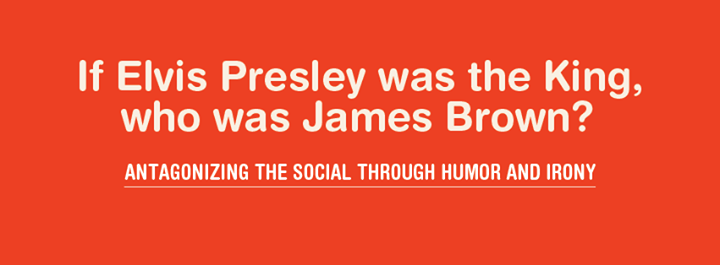IF ELVIS PRESLEY WAS THE KING, WHO WAS JAMES BROWN?

A Group Exhibition with Senalka Mcdonald, Alex Wang, Carolina Caycedo, John Leaños, Rafael Suarez, Martin Sammy Gardea, Mark Benson, Neil Rivas, Casie Thornton, and Colleo.
If no one expects a discourse about tragedy to be tragic, don't expect a discourse about humor to be funny. Humor and irony can be explored beyond the scope of comedy, but a way of processing, challenging, and reassessing knowledge, agreements, social rules, and even the law. Humor and irony is not about making fun of human existence, rather points to the contradictions and misunderstandings of daily life in our mediated world. In this context, humor has the potential to be anarchic and subversive. Wielded by an individual or through a collective voice, humor has the ability to function as a catalyst in establishing new cognitive relations; to make us think, question, and understand quotidian life through a fresh lens.
If Elvis Presley was the King, who was James Brown? * explores the ways in which contemporary artists use humor and irony as strategies to articulate critical and political reflections. The artists who participate in this group exhibition reveal how humor and irony are used to highlight discrimination, war, nationalism, class, power relations, or government policies. Their artworks interpret the world in unconventional ways, offering us new forms of knowledge, experience, and action.
John Leanos's video piece promotes healthy foods over the processed foodstuffs prevalent in lower economic communities, pointing to issues of class, race and privilege in accessing a healthy diet; Martin Sammmy Gardea pens personal notes to financial institutions who offer him credit card services, patiently awaiting a friendly correspondence with these corporate profiteers; Mark Benson's installation reflects on the nature of private and public space, from the privileged entrance to the nuances of how to be “In”; Neil Rivas takes United States immigration policy to task by highlighting the necessity of deporting illegal Superhero characters. The law must be applied to all!; Colleo's small maquettes reflects local concerns on displacement and gentrification; Casie Thornton compares how mass media and higher education are integrated to create the perfect consumer; Rafael Suarez creates a tension between socioproductive endeavors and the spiritual qualities of life; Carolina Caycedo's flags gesture at establishing political relations between historically conflicting countries and cultures by posing the possibility for collaboration and dialogue; Senalka Mcdonald's portraits take on issues of whiteness and forced assimilation into dominate cultures; Alex Wang plays with the function of certain laws that exist in current San Francisco legislation in an exploration of structural discrimination.
If Elvis Presley was the King, who was James Brown? is not a funny show; nor a cynical one. In spite of mass media products, advertisements, and many artworks demonstrate that there's a thin line between humor/irony and cynicism, the artists who participate in this exhibition don't cover and ignore; they precisely act and function as a catalysts to uncover and recognized opening negotiations of power with society, daily life, and art itself. This exhibition aims to continue an ongoing conversation where precisely humor and irony play as an antidote against forgetting and dismiss, consent and agreement. The artworks displayed in this exhibition demonstrate that the smile is not only the last thing you can wear, and how some art practices continue to be an effective tool to bring into question and engage within our daily life.
Fred Alvarado & David de Rozas
* based on Amiri Baraka's In the Funky World
